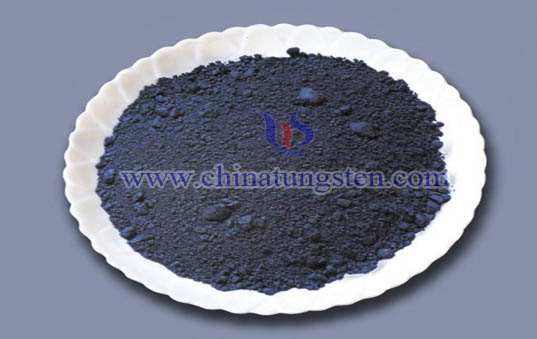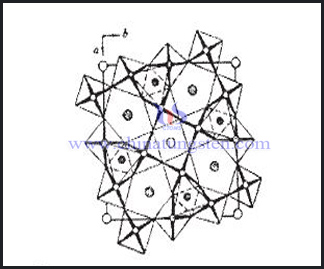Tungsten Bronze

Introduction
The tungsten bronzes are a group of compounds made up of tungsten trioxide, WO3, and an alkali metal, such as sodium (Na), potassium (K), rubidium (Rb), or cesium (Cs). The general chemical form is MxW03, where M=Na, K, Rb, or Cs, and 0< x< 1. The color of these compounds varies with composition, at x=0.93 the color is a bronzelike golden-yellow; at x=0.32 the color is blue violet.
The variation in composition also affects the structure of the compound. Imagine a cube with a tungsten atom at each corner, an oxygen atom in the middle of each edge and an atom of an alkali metal in the center of the cube. However, in a tungsten bronze there is not an atom at the center of every cube. When x < 1, only a certain fraction of the cubes will contain an alkali atom. If x is large, close to 1, the structure of the crystal lattice will be cubic. As x decreases, fewer of the cubes are filled, the structure changes. At about x < 0.3, or with less than 30% of the cubes full, the structure becomes hexagonal, with atoms arranged in hexagonal plates.
The cubic arrangement described above with an atom in the center of a cube is typical for perovskites, a group of ceramic materials with a variety of interesting electrical properties. The high temperature superconductors are among these. In the cubic phase, tungsten bronzes are metallic and conduct electricity. However, in the hexagonal phase, they become superconducting.
Classification
Tungsten bronze has special space tunnel structure, classified by crystalline structure, it can be divided into perovskite tungsten bronze (PTB), tetragonal tungsten bronze(TTB), hexagonal tungsten bronze(HTB) and intergrowth tungsten bronze(ITB). PTB and HTB belong to special non-stoichiometricm tungsten bronze can be divided into the same category as non-stoichiometricmn compound. W exists as W6+, W5+ and W4+ in tungsten bronze to balance the electrical charge of compound. Tunnel structure and its special valence state makes it have superior electrical and ion conducting property, superconducting and photochromic property. Its application in storage battery, electrochromism and chemical sensor has draw great attention.
1. Non-stoichiometricmn compound
PTB and HTB are special non-stoichiometricmn tungsten bronze, its chemical formula is MxWO3(0< x < 1 ), M can be alkali metal like K, Na, or Ca、Sr、Ba and other rare earth metal like Cu, Ag, H. They have high electrical conducting property and fast ion transport property, its electrical conducting rate can reach 2.5X106 S/m which belongs to low temperature super conductor.
2. Intergrowth tungsten bronze
ITB contains B2O62- is due to lack of O or the extra ion B, or BO takes the biggest vacancy of the compound. Usually, it can be expressed as(AO)m.(B2O5)n or(AO)m.(BO3)n according to its valence state. BaO. The main products are(Nb2O5)2、BaO.(Ta2O5)2、Nb8W9O47.
3. Tetragonal tungsten bronze
TTB is the mostly seen and used in the tungsten bronze structure, it has become the focus of research and development. Many orthogonality tungsten bronze is the super structure of TTB, so it is classified into TTB.
Preparation
1. Wet chemical method
Wet chemical method is firstly applied in the preparation of HxWO3. The common wet chemical method preparation method contains the steps of: Soaking WO3 crystalline in acid and metal power(Zn, Pb, Sn) solution, react in special container(such as Jones reactor, can realize separating between reactant and air). During processing, H enters into vacancy of WO3. For example, H0.3WO3 of hexagonal structure can be prepared by hexagonal WO3, hydrochloric acid and Zn.
Precursor compound decomposes in solution can obtain tungsten bronze. For example, APT (NH4)10(W12O41) 5H2O mixed with solution like glacial acetic acid and heating to 200 ℃,hexagonal structure (NH4)xWO3 can be obtained.
Due to low temperature during synthesis process, the crystalline state of product is better so the method has become the focus of research.
2. Thermal reduction method
2.1 Phase-phase heating reduction method
Below is the preparing process: Mix WO3, tungsten metal powder or WO2 and tungstate of metal M, heat it to 1000℃ under vacuum atmosphere or inert atmosphere. Then remove the impurities to get MxWO3. Reaction equation is :
x/2M2WO4 + (1-x)WO3 + x/2WO2→MxWO3
2.2 Thermal decomposition method
Heating precursor compound like HPAs complex, peroxy-HPAs complex and other complex compound containing tungsten can decompose tungsten bronze. The thermal decomposition method of APT to obtain hydrogen tungsten bronze contains following steps:
1) Heating APT: (NH4)10(H2W12O42)7H2O under 100 ~200 ℃ to obtain (NH4)10(W12O41)5H2O;
2) (NH4)10(W12O41)5H2O is continued to decompose into (NH4)0.33WO3 under 200-250 ℃;
3) Under 250-575 ℃, (NH4)0.33WO3 shows great stability, it turns into H0.33WO3 and WO3.
Among which (NH4)xWO3 can be decomposed into HxWO3 under 150-350 ℃ with change in crystalline structure, chemical equation is: (NH4)xWO3=HxWO3+xNH3(g).
3. Electrochemical method
Electrochemical method is the common used in the preparation of hydrogen tungsten bronze and lithium tungsten bronze. Its producing process contains: converting WO3 into electrode, then using WO3 electrode as cathode, using graphite or Pt as anode, electrolysis in sulfide acid or nitric acid can get hydrogen tungsten bronze or lithium tungsten bronze, the chemical equation is as following:
xH++WO3+xe=HxWO3
xLi++WO3+xe=LixWO3
Property and application
Tungsten bronze has good electronic and ionic conductivity, superconductivity and optical properties, which has broad application prospects. In these performance of tungsten bronze, the conductivity and superconductivity have been researched earlier, especially the superconducting properties, which had become the focus in the sixties and seventies. Although there are reports about tungsten bronze type conductivity and electron conduction now, the conductivity and superconductivity is no longer the main content of performance studies.
Tungsten bronze was formed after counterion embedded in WO3 under certain conditions, and it has colors itself because of the absorption and scattering of light, and the intensity of the absorption and scattering change with the x value changing, which also makes tungsten bronze present different colors. Optical properties of tungsten bronze are more prominent because of plasma H+, Li+, Na+ and Ag+ embedding, of which there’re more researches. In which HxWO3 has strongest absorption of light, Li + followed. However, lithium and sodium tungsten bronze have maximum light absorption when x ≈ 0.6, while the hydrogen tungsten bronze does not.
Electrochromism device and photochromism device as two important aspects of the tungsten bronze applications, optical performance is one of its basic principles. Electrochromism applications are related to plasma H+ and Li+ electrochemical reversible embedding on WO3 electrode.
Optical embedding is that plasma H+, Li+ and Na+ into WO3 reversibly solid under irradiation of light, which is also an important performance of tungsten bronze, and it is the basic reactions to achieve color light system, photoelectric conversion and other applications. Because it’s the mixture of WO3 and tungsten bronze after intervention, this effect was also seen as an optical doping process.
New performance of humidity sensitive properties to the sensitive nature of some chemicals may also makes tungsten bronze effective application in humidity measuring instruments, chemical sensors and other devices.


